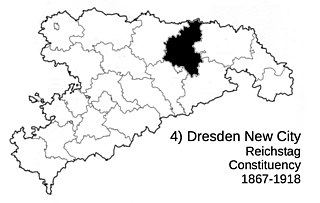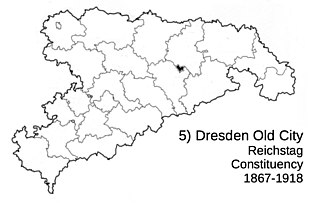
The Zittau Reichstag constituency was constituency No. 1 in the Kingdom of Saxony which returned a deputy to the German Reichstag. It is based upon the town of Zittau.

The Glauchau-Meerane Reichstag constituency was constituency No. 17 in the Kingdom of Saxony which returned a deputy to the German Reichstag. It included Glauchau, Meerane and Hohenstein-Ernstthal located in Chemnitzer Land.

The Chemnitz Reichstag constituency was constituency No. 16 in the Kingdom of Saxony which returned a deputy to the German Reichstag. It was based upon what was the town of Chemnitz.

The Dresden New City Reichstag constituency was constituency No. 4 in the Kingdom of Saxony which returned a deputy to the German Reichstag. It was based upon the area to the north of Dresden.

The Dresden Old City Reichstag constituency was constituency No. 5 in the Kingdom of Saxony which returned a deputy to the German Reichstag. It was based upon the Old CIty area of Dresden.
The Dresden County Reichstag constituency was constituency No. 6 in the Kingdom of Saxony which returned a deputy to the German Reichstag. It was based upon the rural area around Dresden.
The Meissen Reichstag constituency was constituency No. 7 in the Kingdom of Saxony which returned a deputy to the German Reichstag. It was based upon the town of Meissen.
The Pirna Reichstag constituency was constituency No. 8 in the Kingdom of Saxony which returned a deputy to the German Reichstag. It was based upon the town of Pirna.
The Freiberg Reichstag constituency was constituency No. 9 in the Kingdom of Saxony which returned a deputy to the German Reichstag. It was based upon the town of Freiberg.
The Döbeln Reichstag constituency was constituency No. 10 in the Kingdom of Saxony which returned a deputy to the German Reichstag. It was based upon the town of Döbeln.
The Oschatz-Grimma Reichstag constituency was constituency No. 11 in the Kingdom of Saxony which returned a deputy to the German Reichstag. It was based upon the towns of Oschatz and Grimma.
The Leipzig City Reichstag constituency was constituency No. 13 in the Kingdom of Saxony which returned a deputy to the German Reichstag of the German Empire. It was based upon the city of Leipzig.
The Borna Reichstag constituency was constituency No. 14 in the Kingdom of Saxony which returned a deputy to the German Reichstag. It was based upon the town of Borna.
The Mittweida Reichstag constituency was constituency No. 15 in the Kingdom of Saxony which returned a deputy to the German Reichstag. It was based upon the town of Mittweida.
The Zwickau Reichstag constituency was constituency No. 18 in the Kingdom of Saxony which returned a deputy to the German Reichstag. It was based upon the town of Zwickau.
The Stollberg-Schneeberg Reichstag constituency was constituency No. 19 in the Kingdom of Saxony which returned a deputy to the German Reichstag. It was based upon the towns of Stollberg and Schneeberg.
The Marienberg Reichstag constituency was constituency No. 20 in the Kingdom of Saxony which returned a deputy to the German Reichstag. It was based upon the town of Marienberg.
The Annaberg Reichstag constituency was constituency No. 21 in the Kingdom of Saxony which returned a deputy to the German Reichstag of the German Empire. It was based upon the town of Annaberg.
The Auerbach Reichstag constituency was constituency No. 22 in the Kingdom of Saxony which returned a deputy to the German Reichstag of the German Empire. It was based upon the town of Auerbach.
The Plauen Reichstag constituency was constituency No. 23 in the Kingdom of Saxony which returned a deputy to the German Reichstag. It was based upon the town of Plauen.






